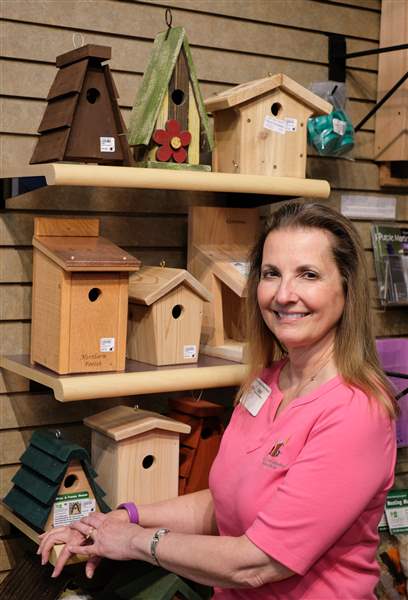
Making a birdhouse a home: What to know to attract friends in flight
5/15/2018
Deb Collette, assistant manager at Wild Birds Unlimited, with some bird houses at the Monroe Street store.
THE BLADE/JEREMY WADSWORTH
Buy This Image
A beginner birdhouse is about as ubiquitous a woodshop project as can be imagined. But what sort of bird can you expect to nest under the steeple of its carefully hammered roof?
Well, that depends.
For cavity nesters like wrens, chickadees, titmice, woodpeckers, and bluebirds, birdhouses can be a welcome habitat amid residential neighborhoods. But a wide variety of birds are attracted to a wide variety of birdhouses, according to area experts, who explained that slight variations in style and positioning can make a box more or less attractive to a particular species.
The most important consideration: size.
“You’re not going to try to get a wood duck into a bluebird box, you know?” said Jason Guerard, outreach director for the Oak Harbor, Ohio-based Black Swamp Bird Observatory, which on Sunday wrapped up its Biggest Week in American Birding festival.
WATCH: Deb Collette explains what birds look for in potential nest boxes
Size covers both the size of the cavity and the size of the hole that a bird uses to enter and exit. A petite chickadee can squeeze through as a hole as small as a 1⅛ inches, while a bluebird is better suited to 1½ inches. A comparatively big wood duck needs closer to 4 inches.
Preferred schematics for common species are readily available online, and bird-lovers with their hearts set on attracting a specific bird can find additional resources at shops like Wild Birds Unlimited or Titgemeier's Feed & Garden Center, each of which sell a variety of birdhouses.
But keep in mind it’s not an exact science.
“You’re going to attract anything that can fit inside it, really,” Mr. Guerard said.
That means smaller species won’t turn up their beaks at larger boxes. But if you’re angling for a specific species, especially a small species like a chickadee or a wren, there’s value in going with a size-specific nest box, Mr. Guerard said. That can protect against predators, like raccoons that might want to reach a paw in to swipe an egg, as well as other species of birds, like house sparrows, that are known to take over existing nests.
(A tunnel-like attachment can also provide that protection in some cases, Mr. Guerard said. A bluebird will be able to squeeze through a tunnel into the box, but sparrows and most predators won’t.)
If size is the most important consideration when catering a birdhouse to a bird, then location is perhaps a close second. Not every yard will be suited to attract a given species, said Deb Collette, assistant manager at Wild Birds Unlimited in Toledo, but there are also ways a bird-lover can position a nest box to help entice a favorite species to put down roots.
An example: the bluebird.
“Not everyone’s yard will get a bluebird, even if you put up a house,” Ms. Collette said. But, if you are going to put up a house, try positioning it out in the open, maybe on a pole in the middle of a yard, rather than tucked against a home or in a tree.
“If you’re looking to attract a wren — a wren is happy if you hang the house in the foliage. They don’t mind that at all,” she said. “But a bluebird wants to be able to look around; it wants to watch for predators. They’re insect-eaters, so they’ll jump down and go after an insect. They want that kind of an environment.”
Location can also mean proximity to other birds and other birdhouses, as Mr. Guerard pointed out. Tree swallows, for example, won’t typically nest near each other, he said. But they won’t necessarily squawk at sharing an side-by-side houses with a bluebird.
Alternatively, purple martins are colonial nesters, meaning they like to nest in groups. Their preferred birdhouses contain multiple cavities.
There are a few tips that make a nest box attractive to any potential nester. When building or purchasing a birdhouse, Mr. Guerard and Ms. Collette advised looking for ventilation, natural materials, and a means of cleaning out the cavity once the chicks have fledged.
Once you have a birdhouse selected, Ms. Collette said the most important thing is to position it so that its entrance faces east-southeast, away from prevailing winds.
“Otherwise, those birds know the rain is going to pour in, the wind is going to pour in on those babies,” she said. A first-time nester might start a nest in an unfavorably positioned nest, she said, but don’t expect them to stick around long.
“They figure out pretty quick that it’s not going to work out,” she said.
Research is key in the hunt for the optimal bird house. For advice on attracting specific species, a basic Internet search is a good resource; so are more specific organizations, like the North American Bluebird Society, which offers nest box building plans on its website.
“Just do research on the species you’re interested in,” Mr. Guerard said. “Get to know the birds in your area, what cavity nesters you might have.”
Then wait. And enjoy.
Contact Nicki Gorny at ngorny@theblade.com or 419-724-6133.